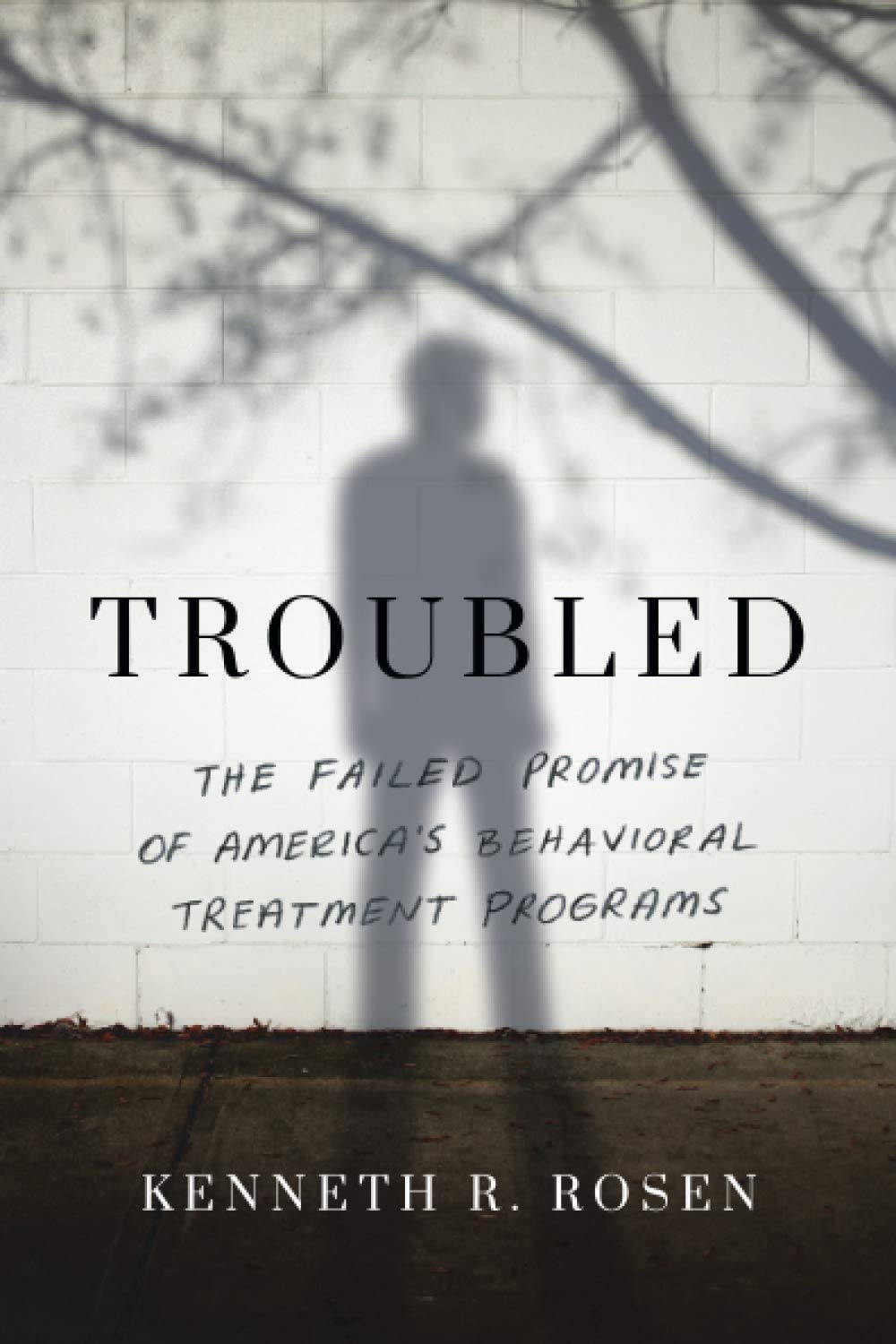interviews
Investigating the Dark Side of America’s Teen Behavioral Treatment Programs
In “Troubled,” Kenneth R. Rosen follows four adolescents through a network of unregulated camps and schools

In his new book Troubled: the Failed Promise of America’s Behavioral Treatment Programs, investigative journalist Kenneth R. Rosen follows four adolescents through the multi-billion dollar troubled teen industry (TTI), the largely unregulated network of wilderness survival camps, residential treatment centers, and “therapeutic” boarding schools which claim to use “tough love” to rehabilitate so-called troubled youth. In Troubled, Rosen explores how many adolescents are subjected to systematic physical, sexual, and emotional abuse designed to break their will in the guise of treatment.
Rosen, a contributing writer at WIRED, the journalist-in-residence at the Washington Institute for Near East Policy, and author of Bulletproof Vest, among other accolades, isn’t just reporting on the TTI. He is also a former client investigating the story he’s been obsessed with since 2007 when he entered the industry and was sent to three different programs in New York, Massachusetts, and Utah. While reporting Troubled, Rosen interviewed more than 100 TTI clients, as well as their parents, psychologists, educational consultants, and other health care professionals, ultimately focusing on four individuals.
Like Rosen, I am a survivor of the TTI. I too have spent a portion of my adult life driven to investigate and share my story in order to protect kids currently enrolled in the TTI.
Rosen and I discussed investigating the story you have been obsessed with for most of your life, why society doesn’t trust survivors, and the struggle to dismantle a multi-billion dollar industry.
Deirdre Sugiuchi: The troubled teen industry damages a lot of people. Why do you think it has survived for so long?
Kenneth R. Rosen: The only change that is going to come is if the survivors and the people who want to change these programs have an equally strong lobby with deep, deep pockets.
One of the talking points I have been pressing is reforming the family, reforming the institutions back home, because the undertaking of dismantling a multi-billion dollar industry that has been thriving—not because they are good at what they do, but because they have predatory practices to reel in unsuspecting parents—means that we are against something much larger than a hashtag can handle.
It would be very nice if we could get regulation to shut down all the programs, if there is a solid movement, if there is cohesion together and moving towards state and federal legislation. Barring that the best thing we can do to keep these programs from harming children is to work on the family unit and say these alternatives are not alternatives. The best we can do is say the parents could use a little bit of help too. The kids may not be the whole issue here.
We need to look at putting all that money back in the community. Rather than putting $40 grand a year in tuition out-of-state, why don’t we start investing that in local hospitals, outpatient programs?
DS: In the book, you discuss how you began writing this in 2007, when you entered the program. Did you understand your problems as a family issue then? I remember being 15-years-old, and sitting at the table at my program, and looking at the different girls, thinking: “your parents divorced; your dad died; you were raped,” thinking that all of our problems are so much bigger than us.
KR: Even in the wilderness, a fundamental treatment plan, I remember thinking “that guy, his pupils are dilated really bad, and you’re just going to drop him in the woods? With some kids? That’s not something you treat that way. That requires some medical supervision or something that is not available in wilderness.”
From the beginning, it dawned on me that there were issues, that there was no way these kids were going to be treated properly. I identified the people who had real struggles back home, but then you’re sitting in a group of 20-25 kids and the therapist goes, “Why don’t you tell about the time your uncle raped you?”
And I remember being mortified for that young woman, [asked] to sit there and talk about that [issue] which she doesn’t want to talk about, so she never gets to really address it, she just pushes it down to get through the program, and it’s apt to explode later. It’s terrible.
DS: The troubled teen industry is a for-profit system, and, as a rule, is paying the staff the least amount of money possible. Often staff are adults in their early 20s with no experience in childcare or with mental health. How does this impact their clients?
KR: I’m trying to be as even-handed as I can about everything. There is something to be said about the staff who are meant to handle the kids throughout the day, the residential staff.
The dismantling of a thriving multi-billion dollar industry means that we are up against something much larger than a hashtag can handle.
Unfortunately, they step into this role, the Stanford Prison experiment ideology, or these ad-hoc therapy sessions, or these restraints that end up killing people. They’re not supposed to be intervening. They’re underpaid and they’re not trained well because they’re not supposed to interventionists. I just looked at a bill that Oregon State Senator Sarah Gelser sent me, a draft bill, asking for my thoughts, and it noted that anyone seeking a referral to a program should also be made aware of the qualifications of the therapeutic staff and to know how often the residential staff is on shift in comparison to the therapeutic staff. I think that’s a fair look, because parents aren’t supposed to be concerned with the guy that’s taking the kids to class or watching the kids play and make sure they don’t hurt themselves, but eventually, you are worried about that person because they intervene.
I was talking to a parent in December, before the book was published, wanting to know where she should send her kid and I was like, “You’re looking for the wrong information from the wrong guy. You have the resources to finance a program like this for your child outright—it paints a picture that to me says you want the best for your kid. You want your child to succeed. So what is it about sending your kid three hours south of Salt Lake City, Utah, in the middle of nowhere makes you think you are getting in any way near the type of treatment in your metropolitan city?”
That’s the disconnect. There’s some thinking that the beauty of remove—this nature, that people will appreciate—is indicative of therapy or beneficial to emotional growth. We see it’s beneficial for veterans, for people with Alzheimer’s, but for children who are going through a difficult time, to put them with unqualified people in the middle of nowhere where there isn’t supervision for the supervisors, which we know time and again is necessary, you’re apt to not get good treatment, plain and simple.
DS: The other night when I was updating my Good Reads account, I noticed on a review of Troubled that someone wrote that because you were a client, you’re biased. What does this type of logic reveal about the way our society doesn’t trust victims and survivors of trauma?
For children going through a difficult time, you’re not getting good treatment by putting them with unqualified people in the middle of nowhere.
KR: I think it would have been unbiased for me to not have disclosed that I went through these programs. I went out of my way to consider everyone’s perspective and to include everyone’s perspective. I’ve heard that people have said that by virtue of me being a survivor or having gone to these programs that I shouldn’t be listened to. Those are the same people that are saying invariably, “Look at him and how great he turned out. He should be an example of why these programs work.” So it’s a cop-out, but it’s also an easy way for them to engage in conversations which are uncomfortable by knocking me down, by knocking the stories down of people who suffered traumatic experiences in these programs. If you don’t engage, you’re always right.
It’s been tough to hear that feedback because I worried I was going to undermine the four main stories I focused on in the book. But I think that I succeeded in a lot of ways by saying this is how everyone felt, by providing a counter-narrative.
DS: I was so heartbroken when I realized you were bearing witness to the stories of kids you went to school with. What was that like to write this as a journalist, to work with subjects you knew personally?
KR: That probably was one of the easiest things I ever had to report. I hugged everyone when I saw them. I thanked them. Oftentimes it was easier to chat than it was in a normal interview. I didn’t feel like I had to worry about where my narrative was. They turned over all their notes. Everyone has saved everything—intake records, psych evaluations, letters with their parents and their grandparents, their caregivers. They turned over their personal journals.
That made my job super easy, but when I sat down to write, I’m looking at these people’s intimate notes on their lives as kids and I have a stack of marble notebooks of my own. I’m just comparing the two and everyone was suffering in their own way and then somehow miraculously we came and met each other every day in the program and would just be these cordial people, but in these notebooks, we would just be these devastated teenagers who wanted everything to go right but nothing was. We wanted to get out and we were trying to get out, but the next day would begin and then we would go to a therapy session. It became our normal vernacular but we were hiding our truest selves.
The writing itself was really difficult because I was living through all these memories again. I was a professional. I was writing so many words a day and then at times I was sort of stepping back and asking my wife to come visit me because I was at a residency. There was one night she came all the way, two hours, to visit because I called her and said I was having a tough time. She came over and I just cried for most of the night. After reading through all the notes and my own personal journals and the stories of these kids—all these things flooded in and I felt that I had not changed. I felt like I was still broken. I felt like I couldn’t tell these stories because I hadn’t grown past them at the end of the day. I do feel like I have a lot of the tendencies I had as a teenager, but I feel like I have been able to compartmentalize them better now.
I hope that all these efforts now— #BreakingCodeSilence, #ISeeYouSurvivor—everyone who is telling their stories and giving their testimonies, I hope they find some solace in that too. I want everyone to know that if offering your testimony and telling your story is the last thing you want to do (to fight) the troubled teen industry, that’s fine. It’s more about you than it is about the industry, because if you can survive and you can move on and become a better person than the person you were 20 years ago, that’s a win, and that means that the program’s lost.









